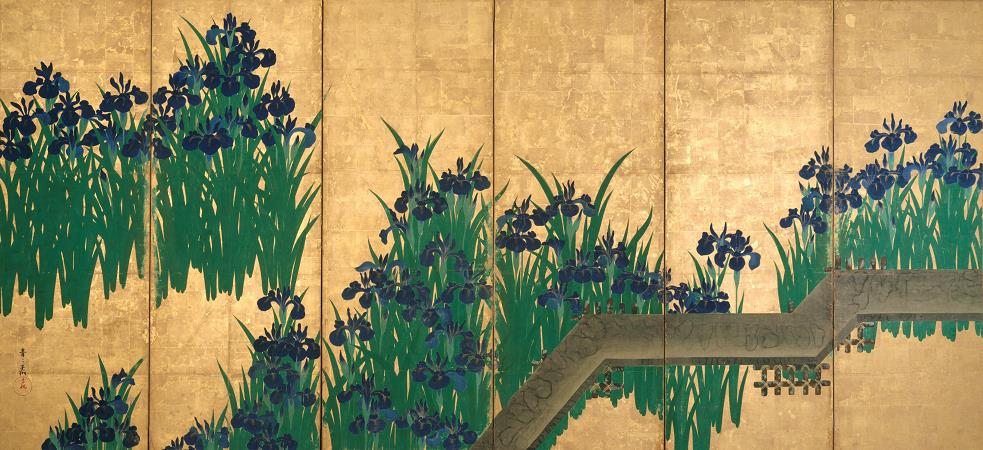Iris. Iris is a genus of 260-300 species of flowering plants with showy flowers. It takes its name from the Greek word for a rainbow, which is also the name for the Greek goddess of the rainbow, Iris. Some authors state that the name refers to the wide variety of flower colors found among the many species. As well as being the scientific name, iris is also widely used as a common name for all Iris species, as well as some belonging to other closely related genera. A common name for some species is flags, while the plants of the subgenus Scorpiris are widely known as junos, particularly in horticulture. It is a popular garden flower. The often-segregated, monotypic genera Belamcanda, Hermodactylus, and Pardanthopsis are currently included in Iris. Three Iris varieties are used in the Iris flower data set outlined by Ronald Fisher in his 1936 paper The use of multiple measurements in taxonomic problems as an example of linear discriminant analysis. Irises are perennial plants, growing from creeping rhizomes or, in drier climates, from bulbs. They have long, erect flowering stems which may be simple or branched, solid or hollow, and flattened or have a circular cross-section. The rhizomatous species usually have 3-10 basal sword-shaped leaves growing in dense clumps. The bulbous species have cylindrical, basal leaves. The inflorescences are in the shape of a fan and contain one or more symmetrical six-lobed flowers. These grow on a pedicel or peduncle. The three sepals, which are usually spreading or droop downwards, are referred to as falls. They expand from their narrow base, into a broader expanded portion and can be adorned with veining, lines or dots. In the centre of the blade, some of the rhizomatous irises have a beard, which are the plants filaments. The three, sometimes reduced, petals stand upright, partly behind the sepal bases. They are called standards. Some smaller iris species have all six lobes pointing straight outwards, but generally limb and standards differ markedly in appearance. They are united at their base into a floral tube that lies above the ovary. The styles divide towards the apex into petaloid branches; this is significant in pollination. The iris flower is of interest as an example of the relation between flowering plants and pollinating insects. The shape of the flower and the position of the pollen-receiving and stigmatic surfaces on the outer petals form a landing-stage for a flying insect, which in probing for nectar, will first come into contact with the perianth, then with the stigmatic stamens in one whorled surface which is borne on an ovary formed of three carpels. The shelf-like transverse projection on the inner whorled underside of the stamens is beneath the overarching style arm below the stigma, so that the insect comes in contact with its pollen-covered surface only after passing the stigma; in backing out of the flower it will come in contact only with the non-receptive lower face of the stigma. Thus, an insect bearing pollen from one flower will, in entering a second, deposit the pollen on the stigma; in backing out of a flower, the pollen which it bears will not be rubbed off on the stigma of the same flower. The iris fruit is a capsule which opens up in three parts to reveal the numerous seeds within. In some species, the seeds bear an aril. Iris is the largest genus of the family Iridaceae with up to 300 species; many of them natural hybrids. Modern classifications, starting with Dykes, have subdivided them. Dykes referred to the major subgroupings as sections. Subsequent authors such as Lawrence and Rodionenko have generally called them subgenera, while essentially retaining Dykes' groupings, using six subgenera further divided into twelve sections. Of these, section Limneris was further divided into sixteen series. Like some older sources, Rodionenko moved some of the bulbous subgenera into separate genera, but this has not been accepted by later writers such as Mathew, although the latter kept Hermodactylus as a distinct genus, to include Hermodactylus tuberosus, now returned to Hermodactyloides as Iris tuberosa. Rodionenko also reduced the number of sections in subgenus Iris, from six to two, depending on the presence or absence of arils on the seeds, referred to as arilate or nonarilate. Taylor provides arguments for not including all arilate species in Hexapogon. In general, modern classifications usually recognise six subgenera, of which five are restricted to the Old World; the sixth has a Holarctic distribution.
more...












